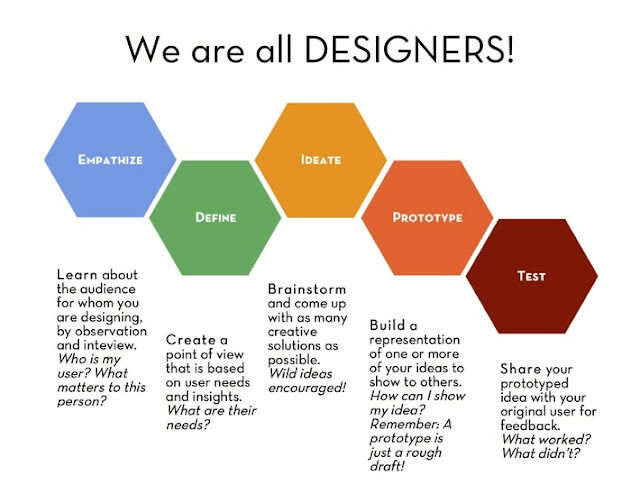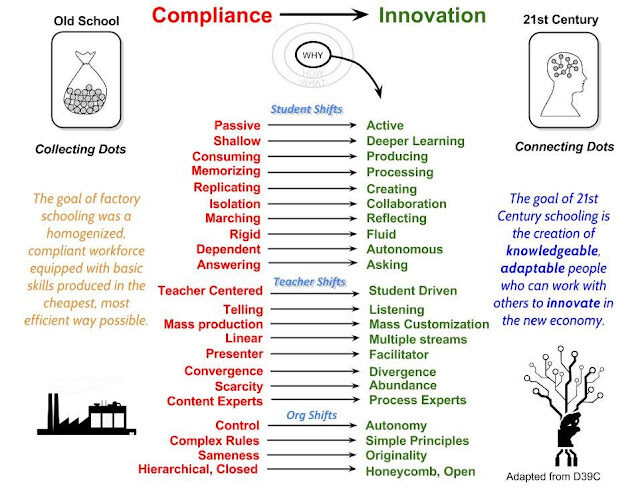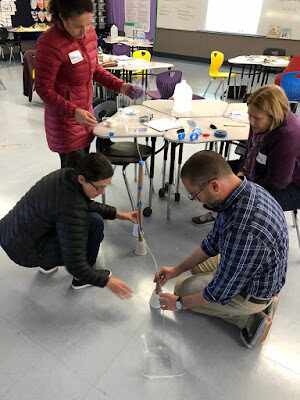Reboot Your Teaching Practice with Design Thinking: 5 Tips to Get Started
Here’s a sign of a powerful professional development event, your laptop, and cell phone never leave your bookbag once. The idea that a 1-day workshop won’t grow dendrites for teachers, has been exclaimed by researchers for decades, yet if the one-day event creates disequilibrium in the way you view teaching and learning it’s possible that change can take place immediately. Researchers say professional development needs to be ongoing and continuous, but when an adult learner experiences a surge of inspiration in a moment in time, the intensity of the experience can disrupt your practice.
This was my experience at DesignCamp Monterey. For those of you unfamiliar with #DesignCamp it is rooted in the philosophy of Design Thinking in which designers tackle problems by rethinking an issue in a human-centric way as a means to explore possibilities and unleash creativity. This is possible with hands-on tasks that have a “low-ceiling and high floor” to engage all learners and promote as many solutions to a problem as possible. Design thinking gets kids to think just like an engineer and view learning as ongoing process which occurs when designers (a.k.a students) partake in an iterative cycle of sketching, prototyping and testing concepts and ideas.
This model of instruction definitely shifts the role of the teacher from the director of information to coach and facilitator. Students immediately take an active role in constructing learning and everyone has a voice and a choice for participation. The process of design is authentic in the sense that children quite naturally are curious, flexible in thinking, and willing to take risks (this reminds you of preschool right).
It is teachers who are most likely static in their approach to instruction, afraid of taking chances and rigid in their thinking. So your biggest challenge might not be will my students be engaged in Design Thinking, but will I be able to get outside my comfort zone. You see the process is learner-directed so the sage on the stage, is more like the coach on the sideline, you still have the expertise and the plays, but it’s your students who will make all the moves.
So what might design thinking look like in your classroom? Think of a concept you might be working on like:
Common Core Math 5 MD.C3 Recognize volume as an attribute of solid figures and understand concepts of volume measurement
Then provide your students with a problem in which they must design a solution:
Students will create and use a model that can transport freshwater over long distances with no human contact in between locations, design a water transportation model to scale, test it to ensure success, and then show and explain how it works. Students iterate and record data as they improve their designs.
This approach to instruction is interdisciplinary in construct and connects various disciplines across the framework of the Four C’s: Creativity, Communication, Collaboration and Critical Thinking.
At our #DesignCamp we participated in several tasks from designing a suit for the Winter Olympics Mardi-gras event based on the users’ needs and interests, to building a rocket, and creating solutions to transport water.
Children as young as Pre-K can engage in an activity that allows them to think creatively and apply solutions. This is what children do naturally from the time they are born. They are testing out their environment and seeing what works.
Here are my 5 Tops Tips for Implementing Design Thinking:
1. Begin with Empathy: when tasks are rooted in empathy the collaboration and culture of the school and classroom shifts to recognize all students as individuals, who they are, what they believe in, and what is important. Building on students’ funds of knowledge is what makes Design Thinking learner-centric, but when the task has meaning and value then students will go deeper with their learning and become passionate about what they are doing.
2. Don’t Go It Alone: If you are new to design thinking you need to share and reflect on your process and what you learned about your students during the task. Create a team of teachers at your school site who can observe your students in action and help you make interdisciplinary connections across subject areas. This is especially important at secondary schools as you will want to consider how you can integrate subjects: Want to see what this looks like in a middle school? Check out Vista Innovation and Design Academy in San Diego
3. Start with a plan and connect the standards: Trying out Design Thinking without a solid plan might be the last time you take a big leap. Your students might think it’s fun, but are they learning? Determine what your goals are for your students, consider the materials and resources needed, and the kinds of tasks that will hook your learner. Without structure, Design Thinking can turn into playtime at Chuck-e-Cheese. Look at these Design Thinking Challenges from Raft Resources that includes standards-based lessons, planning, and include materials and resources to get started immediately.
Check out this video on how students turn trash into fashion for a deep dive into mathematics skills, environmental principles and fashion construction.
4. Stay Connected and Continue to Learn: social media and twitter can get you digitally connected to teachers who have been developing Design Thinking tasks for quite some time. But it’s important to know who to follow on Twitter here are my recommendations:
Principals Dr Chagala @drchagala and Kaleb Brashad @kalebrashad are leaders who are charging their schools forward with Design Thinking. Science teachers Brian Delgado @bluedotbrian and Andrew Lerario @bluedotandrew and English teacher Dan Ryder (@wickeddecent) are forging the way for teachers to jump on board with Design Thinking.
5. Start Small and Stay Humble: this process is definitely not about perfection it’s all about the process. So be gentle with yourself and know that kids are still learning even if you’re not getting the exact results that you want. Learning can occur when mistakes are made and projects fail. Failure is an opportunity for growth and a chance for kids to know that just because you fail does not mean you need to give up. Here’s an inspiring video of kids at HighTech High building a rocket
So if you’ve got a growth mindset and a willingness to step outside of the box, then creating, implementing and facilitating a Design Thinking task is the right step for you. Let us know what works for you, what are your challenges and where you need to grow, because that’s what being humble is all about, and if we can’t own our mistakes how can we teach empathy to others?
Join the digital conversation on our Facebook Group: Teacher Prep Tech








